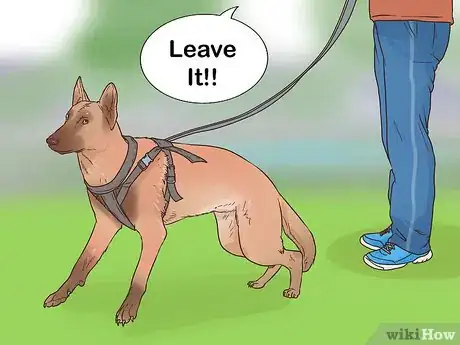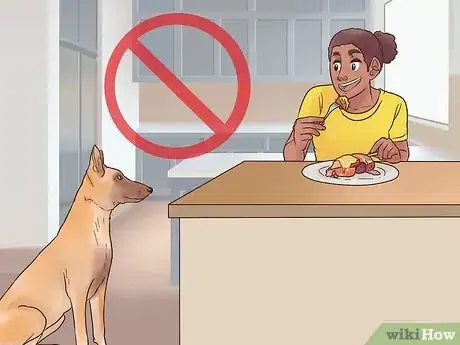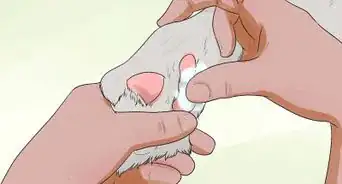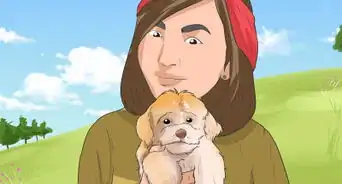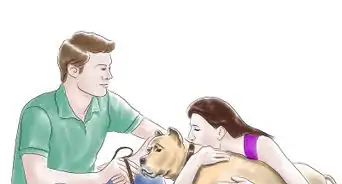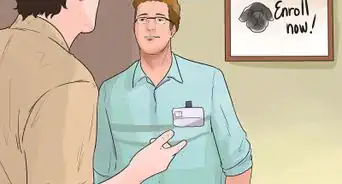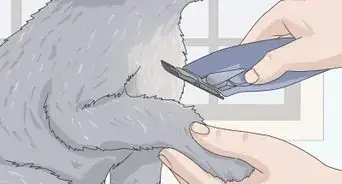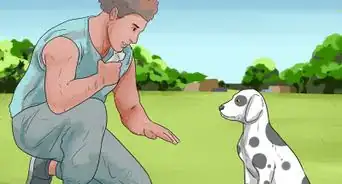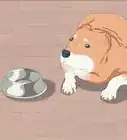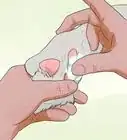This article was co-authored by Jaimie Scott. Jaimie Scott has been training dog owners as the Owner of Jaimie Scott Dog Training in Sacramento, California for the past 15 years. Jaimie meets clients for 1-on-1 training, group classes (owners only, no dogs), as well as live video classes. Jaimie has published videos, blog articles, and eBooks to share tips for training and his personalized insight into dog behavior. With a focus on training the owners, Jaimie believes that dogs need to know who’s in control at any given time in order to feel secure and be happy. Jaimie holds a BS in Mathematics and Computer Science from Pacific University.
wikiHow marks an article as reader-approved once it receives enough positive feedback. In this case, 94% of readers who voted found the article helpful, earning it our reader-approved status.
This article has been viewed 301,834 times.
A Belgian Malinois is a herding dog that has similar attributes to a German shepherd, including that it requires a lot of training and attention. If you want to train a Belgian Malinois, you should start the process at a young age. Early and thorough training can help you eliminate territorial or aggressive behavior, which can pop up in the breed if it is not well trained. With consistent, clear, and experienced training, a Malinois can be trained to do a variety of jobs, including herding and protection jobs.[1]
Steps
Doing Foundational Training
-
1Socialize your dog at a young age. Between the ages of 4 to 14 (or possibly up to 18) weeks old a puppy goes through a period of socialization.[2] You should expose your puppy to a wide variety of places and people during this period, so that it knows that new places and people are a normal part of life.[3]
- Walk or carry your puppy in public places, such as busy shopping streets and marketplaces, so it gets used to being around people. With this type of early exposure, it is less likely to feel threatened when it sees someone it doesn't know.
- Bring a wide variety of people to your home. Having strangers in your home will teach the dog that it is normal for new people to show up and they shouldn't feel threatened by this occurring in the future.
-
2Spend quality time with your dog. Play is essential in a dog's life and it can be very helpful in building a relationship with your dog. Malinois in particular are affectionate dogs that love spending time with their people. Thus, from a young age you should spend quality time with your dog every day. At least 30 minutes of play each day is a good amount for a small puppy, while an older dog can use more time to play and exercise with you.
- For example, you could give your Malinois a small rubber ball to play with. Throw the ball to the puppy and then practice fetching it.
Advertisement -
3Be gentle with your dog. When creating a good foundation for training, you should make sure not to get angry or to be violent with the dog. Malinois do not generally respond to aggressive training techniques. Instead, avoid treating your puppy harshly while its still young so that it will trust you and will be enthusiastic about doing what you ask it to do.[4]
- Manage your expectations for the dog's behavior and focus on creating a bond based in affection instead of fear.
- While it is important to stop negative behaviors, such as going to the bathroom in the house, redirection and showing the dog what it should do instead is much more effective than yelling or hitting the dog. Remember, when you are yelling at a dog it likely has no idea why you are yelling at it.
Teaching Your Malinois Commands
-
1Start training a puppy at 8 weeks old. A young puppy is perfectly capable of learning how to follow your commands and beginning early will help them avoid learning bad habits. Tell the dog to "sit," "stay," and "come" when you want it to do those things. While you shouldn't expect perfect behavior at such a young age, beginning to use verbal commands with the dog will set the foundation for obedience as it ages.
- For a Malinois, starting training this early can be key to helping it develop a pleasing and pleasant personality.
- For example, you should begin house training your puppy as soon as possible. Take it out on a regular schedule and take it to the same spot every time, so that it learns to go to the bathroom only outside.
-
2Use reward-based training techniques. Instead of punishing a dog for doing the wrong thing, give it praise and treats for doing positive things. When it sits, goes to the bathroom outside, or comes when called, give it a pat, tell it how smart it is in a nice voice, or give it a small treat right away. By starting this positive reinforcement early, the dog will strive to do things that please you in the future.
- This positive reinforcement can start very early and using it when the dog is young will help you with more advanced training later.
-
3Consider using clicker training. Clicker training is a reward-based training style that incorporates a distinctive clicking noise as well. This noise is done when the dog does what you have asked it to do, which helps the dog understand when it has completed what it was asked to do.
- Clicker training is a helpful training method because it eliminates some of the confusion that can occur between trainer and dog. When the clicker is clicked right when the dog does what you asked it to do, there is no ambiguity about your commands.
- This can be very helpful when giving a dog extensive and skilled training, which is common with Malinois.
-
4Adjust the length of training sessions as the dog ages. When your Malinois is a young puppy, training sessions should be at most 10 minutes long. As the dog grows up, you can gradually extend each training session to 30 minutes to 1 hour.[5]
- Malinois love learning, being active, and spending time with their owner, so most of them are happy to do several training sessions a day.
-
5Teach the dog to sit. When you want to make the puppy sit, you need to wait for a moment when the dog is about to naturally sit, then say "sit," and give the dog praise and a treat. If you do this repeatedly, the dog will begin to associate the action with the positive reinforcement.
- Try practicing sitting when you are out on walks. When you pause at a corner, be prepared to give treats or praise, as the dog will likely naturally sit when it comes to a stop.
- The time it takes for the dog to learn to sit can vary drastically. It can take a lot of repetitions for your dog to understand your command and why it is getting treats.
-
6Introduce additional commands once the dog has mastered sitting. Sit is the starting point for a variety of other commands, such as stay and lay down. For instance, once the dog is sitting say the word "down" and signal that the dog should lay down. You may need to wait until the dog wants to lay down and give it a treat then, just as you did when teaching the dog to sit.[6]
- Keep in mind the positive reinforcement technique by saying "Good dog" when it does the right thing.
- Keep repeating this routine daily until your dog follows your commands reliably.
Discouraging Bad Behavior
-
1Control your dog's prey drive. To minimize the dog's instinct to attack prey, socialization should be the first but not the only solution. Use the dog's training to instruct it to heel when walking outside. You can also teach a Malinois to "leave it," meaning to leave something alone. Teaching this command with reward-based training can keep your dog's prey drive in check.
- All Malinois have high prey drives, meaning they typically chase small animals like cats, small dogs, and potentially little children. So you need to watch out for this instinct and nip it in the bud.
- Also, when walking your Malinois make sure the leash is held tight, so that the dog doesn't get loose if it lurches at something.
-
2Reduce herding behavior. When a Malinois begins to herd you or other people, you should stop the behavior right away, as it can escalate to nipping quickly. The first line of defense is to give them something to do instead of herding, such as playing with a toy or going for a walk. However, you can also work on the command "stay," which should stop them in their tracks.[7]
- The Malinois is a herding type of dog, so try not to get annoyed if yours tends to follow you all around the house as you move.
- Herding behavior can become especially problematic if your dog begins herding children or elderly people, who may not be stable enough to resist the dog's physical attention.
-
3Reduce begging for food. Make it clear that your meal time is separate from the dog's meal time. As this dog is a work in progress, you need to teach your Belgian Malinois that it is not proper for it to stand in front you while you're eating your meal. Instead, have it in the down position near the doorway while you and your family are having your meals.
Expert Q&A
-
QuestionWhat can I do about an 8 week old puppy that poops and pees everywhere?
 Pippa Elliott, MRCVSDr. Elliott, BVMS, MRCVS is a veterinarian with over 30 years of experience in veterinary surgery and companion animal practice. She graduated from the University of Glasgow in 1987 with a degree in veterinary medicine and surgery. She has worked at the same animal clinic in her hometown for over 20 years.
Pippa Elliott, MRCVSDr. Elliott, BVMS, MRCVS is a veterinarian with over 30 years of experience in veterinary surgery and companion animal practice. She graduated from the University of Glasgow in 1987 with a degree in veterinary medicine and surgery. She has worked at the same animal clinic in her hometown for over 20 years.
Veterinarian At 8 weeks old the pup is a true baby and only just old enough to learn about potty training. Previous accidents were inevitable due to the pup's young age. Start again now. Have a good clean round to remove the pee and poop marker smells. Consider crate training the pup for when you can't be in the room. Give the pup toilet breaks outside every 20 to 30 minutes and make a huge fuss with lots of praise when they do their business outdoors.
At 8 weeks old the pup is a true baby and only just old enough to learn about potty training. Previous accidents were inevitable due to the pup's young age. Start again now. Have a good clean round to remove the pee and poop marker smells. Consider crate training the pup for when you can't be in the room. Give the pup toilet breaks outside every 20 to 30 minutes and make a huge fuss with lots of praise when they do their business outdoors. -
QuestionHow can I train my dog to stop mouthing on people?
 Pippa Elliott, MRCVSDr. Elliott, BVMS, MRCVS is a veterinarian with over 30 years of experience in veterinary surgery and companion animal practice. She graduated from the University of Glasgow in 1987 with a degree in veterinary medicine and surgery. She has worked at the same animal clinic in her hometown for over 20 years.
Pippa Elliott, MRCVSDr. Elliott, BVMS, MRCVS is a veterinarian with over 30 years of experience in veterinary surgery and companion animal practice. She graduated from the University of Glasgow in 1987 with a degree in veterinary medicine and surgery. She has worked at the same animal clinic in her hometown for over 20 years.
Veterinarian When the puppy mouths, have the person squeal and have their hand go limp. Then, ignore the puppy and refuse to play. If this doesn't work, then get up and leave the room. Some pups get so over-excited that even this doesn't work, in which case, play in 15 second bursts, stop, wait for puppy to calm down, then play for another 15 seconds.
When the puppy mouths, have the person squeal and have their hand go limp. Then, ignore the puppy and refuse to play. If this doesn't work, then get up and leave the room. Some pups get so over-excited that even this doesn't work, in which case, play in 15 second bursts, stop, wait for puppy to calm down, then play for another 15 seconds. -
QuestionCan I still train my dog if it's 7 months old?
 Community AnswerOf course! If you need extra help, you can take him/her to training classes.
Community AnswerOf course! If you need extra help, you can take him/her to training classes.
Warnings
- It is important to thoroughly train a Malinois and give it things to do every day. They are bred to be protective and hard-working dogs, so if they are left to their own devices they can become aggressive with strangers, destructive, or generally ill behaved.⧼thumbs_response⧽
References
- ↑ https://www.akc.org/dog-breeds/belgian-malinois/
- ↑ https://www.psychologytoday.com/us/blog/decoding-your-pet/201409/socialization-when-do-it-and-when-not-do-it
- ↑ https://www.akc.org/expert-advice/training/puppy-training/puppy-socialization/
- ↑ http://dogtime.com/dog-breeds/belgian-malinois#/slide/1
- ↑ https://www.akc.org/expert-advice/training/puppy-training/teach-your-puppy-these-5-basic-commands/
- ↑ https://www.akc.org/expert-advice/training/puppy-training/teach-your-puppy-these-5-basic-commands/
- ↑ http://dogtime.com/dog-breeds/belgian-malinois#/slide/1
About This Article
To train a Belgian Malinois, start socializing your dog to a variety of places and people as early as possible. For best results, this should be done when the puppy is between 4 and 14 weeks. At around 8 weeks old, start training the puppy with simple commands like, “Sit,” “Stay,” and “Come.” Reward your dog with praise and treats when it performs these tasks. You can also use clicker training as a positive reinforcement tool. As the dog becomes comfortable with these commands, you can start adding in new ones. For tips from our veterinary co-author on how to discourage your dog from chasing or nipping, read on!









